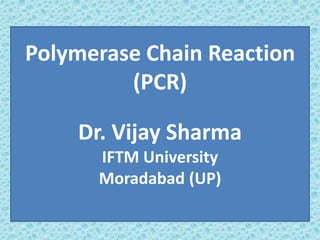Polymerase chain reaction
•
2 likes•197 views
Pharmaceutical Biotechnology
Report
Share
Report
Share

Recommended
Recommended
More Related Content
What's hot
What's hot (20)
combinatorial chemist Piyush lodhi b. pharma 6th sem 

combinatorial chemist Piyush lodhi b. pharma 6th sem
UNIT-5 Protein Engineering: Brief introduction to protein engineering,Use of ...

UNIT-5 Protein Engineering: Brief introduction to protein engineering,Use of ...
PHARMACEUTICAL BIOTECHNOLOGY BY PHARM.ISA HASSAN ABUBAKAR

PHARMACEUTICAL BIOTECHNOLOGY BY PHARM.ISA HASSAN ABUBAKAR
Patenting of natural products by Dr.U.Srinivasa , Professor, Srinivas college...

Patenting of natural products by Dr.U.Srinivasa , Professor, Srinivas college...
Similar to Polymerase chain reaction
Similar to Polymerase chain reaction (20)
More from vijaysrampur
More from vijaysrampur (9)
Preformulation part 1- Preformulation- Crystal, Amorphous, Polymorphism, Pseu...

Preformulation part 1- Preformulation- Crystal, Amorphous, Polymorphism, Pseu...
Preformulation- Crystal, Amorphous, Polymorphism, Pseudo Polymorphism

Preformulation- Crystal, Amorphous, Polymorphism, Pseudo Polymorphism
Recently uploaded
Recently uploaded (20)
Basic Civil Engineering first year Notes- Chapter 4 Building.pptx

Basic Civil Engineering first year Notes- Chapter 4 Building.pptx
Python Notes for mca i year students osmania university.docx

Python Notes for mca i year students osmania university.docx
UGC NET Paper 1 Mathematical Reasoning & Aptitude.pdf

UGC NET Paper 1 Mathematical Reasoning & Aptitude.pdf
Plant propagation: Sexual and Asexual propapagation.pptx

Plant propagation: Sexual and Asexual propapagation.pptx
Interdisciplinary_Insights_Data_Collection_Methods.pptx

Interdisciplinary_Insights_Data_Collection_Methods.pptx
ICT Role in 21st Century Education & its Challenges.pptx

ICT Role in 21st Century Education & its Challenges.pptx
Unit 3 Emotional Intelligence and Spiritual Intelligence.pdf

Unit 3 Emotional Intelligence and Spiritual Intelligence.pdf
ICT role in 21st century education and it's challenges.

ICT role in 21st century education and it's challenges.
Salient Features of India constitution especially power and functions

Salient Features of India constitution especially power and functions
Kodo Millet PPT made by Ghanshyam bairwa college of Agriculture kumher bhara...

Kodo Millet PPT made by Ghanshyam bairwa college of Agriculture kumher bhara...
Exploring_the_Narrative_Style_of_Amitav_Ghoshs_Gun_Island.pptx

Exploring_the_Narrative_Style_of_Amitav_Ghoshs_Gun_Island.pptx
21st_Century_Skills_Framework_Final_Presentation_2.pptx

21st_Century_Skills_Framework_Final_Presentation_2.pptx
Polymerase chain reaction
- 1. Polymerase Chain Reaction (PCR) Dr. Vijay Sharma IFTM University Moradabad (UP)
- 2. What is PCR • Polymerase chain reaction (PCR) is a method used widely in molecular biology to make millions to billions of copies of a specific DNA sample rapidly, allowing scientists to take a very small sample of DNA and amplify it to a large enough amount to study in detail. • PCR was invented in 1983 by the American biochemist Kary Mullis.
- 3. • It is fundamental to much of genetic testing including analysis of ancient samples of DNA and identification of infectious agents. Using PCR, copies of very small amounts of DNA sequences are eponentially amplified in a series or cycles of temperature changes. PCR is now a common and often indispensable technique used in medical laboratory and clinical laboratory research for a broad variety of applications including biomedical research and criminal forensics.
- 4. Restricted Endonuclease Restricted Endonuclease Recombinant DNA Introduced in Host (E. Coli) Multiplication Conventional Genetic Engineering Technique DNA Ligase
- 5. Components of PCR set ups • A basic PCR set-up requires several components and reagents including: 1. DNA template that contains the DNA target region to amplify. 2. DNA polymerase; an enzyme that polymerizes new DNA strands; heat-resistant Taq polymerase is especially common, as it is more likely to remain intact during the high- temperature DNA denaturation process.
- 6. Components of PCR set ups 3. Two DNA primers that are complementary to the 3' (three prime) ends. DNA polymerase can only bind to and elongate from a double-stranded region of DNA; without primers there is no double-stranded initiation site at which the polymerase can bind. • 4. Nucleotides containing triphosphate groups also called building blocks from which the DNA polymerase synthesizes a new DNA strand.
- 7. • 5. A buffer solution providing a suitable chemical environment for optimum activity and stability of the DNA polymerase Containing mutagen like magnesium (Mg) or manganese (Mn) ions; potassium (K) ions Components of PCR set ups
- 8. Thermal Cycler of PCR & PCR tubes
- 9. Procedure • The individual steps common to most PCR methods are as follows: Initialization: • This step is only required for DNA polymerases that require heat activation by hot-start PCR. • It consists of heating the reaction chamber to a temperature of 94–96 °C, or sometimes 98 °C if extremely thermostable polymerases are used.
- 10. Denaturation • It consists of heating the reaction chamber to 94–98 °C for 20–30 seconds. • This causes DNA melting, or denaturation, of the double-stranded DNA template by breaking the hydrogen bonds between complementary bases, yielding two single- stranded DNA molecules. Procedure
- 11. Initiation Temp. 94–96 °C • . Denaturation Temp. 94–98 °C
- 12. Annealing • In this step, the reaction temperature is lowered to 50–65 °C for 20–40 seconds, allowing annealing of the primers to each of the single- stranded DNA templates. • Two different primers are typically included in the reaction mixture. • One for each of the two single-stranded complements containing the target region. • The primers are single-stranded sequences themselves, but are much shorter than the length of the target region. Procedure
- 13. • Extension/elongation • In this step the reaction temperature is kept 75- 80°C for Taq polymerase enzyme though a temperature of 72 °C is commonly used with this enzyme. • In this step, the DNA polymerase synthesizes a new DNA strand complementary to the DNA template strand by adding free nucleotides. • The precise time required for elongation depends both on the DNA polymerase used and on the length of the DNA target region to amplify. Procedure
- 14. • . Annealing Temp. 50–65 °C Extension Temp. 75-80°C